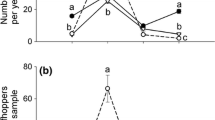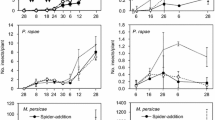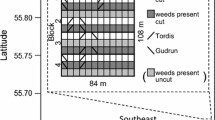Abstract
Modern agricultural pest management systems rely on naturally occurring generalist predators to promote pest suppression. Still, little research has been done to assess their overall effectiveness, especially over the winter period when their potential is high. In this study, we focused on three genera of winter-active spiders Clubiona, Philodromus, and Anyphaena, common predators on pear trees in Central Europe during winter and early spring. We investigated their predation activity, natural diet, and prey preference using molecular gut content and abundance data obtained from cardboard bands, which served as natural shelters. We compared these characteristics between two distinct biocontrol-promoting managements—integrated pest management (IPM) and organic management (ORG). We found the proportion of prey-positive spider individuals during the winter period to be lower compared to the spring period with Anyphaena having by far the highest proportion. The prey composition during winter was more diverse in ORG orchards, but in both managements, it was inclined toward pests, mostly pear psyllids. Conversely, in early spring, despite psyllids still being a part of the diet, spiders in IPM orchards preyed more frequently on neutral prey (mostly dipterans), while the spiders from organic orchards preyed mostly on pests (lepidopterans). Although more data are needed to assess trophic interactions and the overall efficiency of these winter-active predators in complex arthropod food webs present in pear orchards, the results obtained from this research provide the first evidence of higher pest predation during a period of agricultural quiescence.





Similar content being viewed by others
Availability of data and materials
The data are available in supplementary materials.
References
Allaire JJ, Gandrud C, Russell K, Yetman CJ (2017) networkD3: D3 JavaScript Network Graphs from R. R package version 0.4. https://CRAN.R-project.org/package=networkD3. Accessed February 2022.
Altschul SF, Gish W, Miller W, Myers EW, Lipman DJ (1990) Basic local alignment search tool. J Mol Biol 215(3):403–410. https://doi.org/10.1016/S0022-2836(05)80360-2
Athey KJ, Dreyer J, Kowles KA, Penn HJ, Sitvarin MI, Harwood JD (2016) Spring forward: molecular detection of early season predation in agroecosystems. Food Webs 9:25–31
Belkair SA, Mazzia C, Pasquet A, Capowiez Y (2018) Temporal activity of spiders and earwigs during winter in apple trees under a Mediterranean climate. Biocontrol Sci Technol 28(9):823–836. https://doi.org/10.1080/09583157.2018.1499870
Beneš J, Konvička M, Dvořak J, Fric, Z, Havelda Z, Pavlíčko A, Vrabec V, Weidenhoffer Z (2002) Butterflies of the Czech Republic: Distribution and conservation I, II. SOM, Prague.
Birkhofer K, Gavish-Regev E, Endlweber K, Lubin Y, Von Berg K, Wise D, Scheu S (2008) Cursorial spiders retard initial aphid population growth at low densities in winter wheat. Bull Entomol Res 98(3):249–255. https://doi.org/10.1017/S0007485308006019
Birkhofer K, Arvidsson F, Ehlers D, Mader VL, Bengtsson J, Smith HG (2016) Organic farming affects the biological control of hemipteran pests and yields in spring barley independent of landscape complexity. Landsc Ecol 31(3):567–579. https://doi.org/10.1007/s10980-015-0263-8
Birkhofer K, Djoudi EA, Schnerch B, Michalko R (2022) Climatic conditions and functional traits affect spider diets in agricultural and non-agricultural habitats worldwide. Ecography. https://doi.org/10.1111/ecog.06090
Bogya S (1995) Kalitpókok (Clubionidae), mint a biológiai védekezés perspektivikus eszközei almagyümölcsösben. Növényvédelem 31:149–153
Bogya S (1999) Spiders (Araneae) as polyphagous natural enemies in orchards. PhD thesis. University of Wageningen, Netherlands.
Bohmann K, Elbrecht V, Carøe C, Bista I, Leese F, Bunce M, Yu DW, Seymour M, Dumbrell A, Creer S (2022) Strategies for sample labelling and library preparation in DNA metabarcoding studies. Mol Ecol Resour 22:1231–1246. https://doi.org/10.1111/1755-0998.13512
Boreau De Roincé C, Lavigne C, Mandrin JF, Rollard C, Symondson WOC (2013) Early-season predation on aphids by winter-active spiders in apple orchards revealed by diagnostic PCR. Bull Entomol Res 103:148–154. https://doi.org/10.1017/S0007485312000636
Buchar J, Ducháč V, Hůrka K, Lellák J 1995. Klíč k určování bezobratlých. Scientia, Prague
Bushnell B, Rood J, Singer E (2017) BBMerge—accurate paired shotgun read merging via overlap. PLoS ONE 12(10):e10185056. https://doi.org/10.1371/journal.pone.0185056
Cardoso P, Pekár S, Jocqué R, Coddington JA (2011) Global patterns of guild composition and functional diversity of spiders. PLoS ONE 6(6):21710. https://doi.org/10.1371/journal.pone.0021710
Černecká Ľ, Michalko R, Krištín A (2017) Abiotic factors and biotic interactions jointly drive spider assemblages in nest-boxes in mixed forests. J Arachnol 45(2):213–222. https://doi.org/10.1636/JoA-S-15-005.1
Chatterjee S, Isaia M, Venturino E (2009) Spiders as biological controllers in the agroecosystem. J Theor Biol 258(3):352–362. https://doi.org/10.1016/J.JTBI.2008.11.029
Cirtwill AR, Hambäck P (2021) Building food networks from molecular data: Bayesian or fixed-number thresholds for including links. Basic Appl Ecol 50:67–76. https://doi.org/10.1016/j.baae.2020.11.007
Civolani S (2012) The past and present of pear protection against the pear Psylla, Cacopsylla pyri L. In: Perveen F (ed) Insecticides—Pest Engineering. Intech Open, London, pp. 385– 408. https://doi.org/10.5772/28460
Cuff JP, Drake LE, Tercel MPTG, Stockdale JE, Orozco-terwengel P, Bell JR, Vaughen IP, Müller CT, Symondson WOC (2020) Money spider dietary choice in pre-and post-harvest cereal crops using metabarcoding. Ecol Entomol 46(2):249–261. https://doi.org/10.1111/een.12957
Cuff JP, Tercel PTG, Drake LE, Vaughan IP, Bell JR, Orozco-terWengel P, Müller CT, Symondson WO, Jordan Cuff CP (2022a) Density-independent prey choice, taxonomy, life history, and web characteristics determine the diet and biocontrol potential of spiders (Linyphiidae and Lycosidae) in cereal crops. Environ DNA 4(3):549–564. https://doi.org/10.1002/edn3.272
Cuff JP, Kitson JJN, Hemprich-Bennett D, Tercel MPTG, Browett SS, Evans DM (2022b) The predator problem and PCR primers in molecular dietary analysis: swamped or silenced; depth or breadth? Mol Ecol Resour. https://doi.org/10.1111/1755-0998.13705
Daugherty MP, Briggs CJ, Welter SC (2007) Bottom-up and top-down control of pear psylla (Cacopsylla pyricola): Fertilization, plant quality, and the efficacy of the predator Anthocoris nemoralis. Biol Control 43(3):257–264. https://doi.org/10.1016/J.BIOCONTROL.2007.09.001
Deagle BE, Thomas AC, McInnes JC, Clarke LJ, Vesterinen EJ, Clare EL, Kartzinel TR, Eveson JP (2019) Counting with DNA in metabarcoding studies: How should we convert sequence reads to dietary data? Mol Ecol 28(2):391–406. https://doi.org/10.1111/mec.14734
DeBach P (1964) Biological control of insect pests and weeds. Chap-Man & Hall, London, p 844
DeBach P, Rosen D (1991) Biological control by natural enemies. Cambridge University Press, London
Diehl E, Mader VL, Wolters V, Birkhofer K (2013) Management intensity and vegetation complexity affect web-building spiders and their prey. Oecologia 173(2):579–589. https://doi.org/10.1007/s00442-013-2634-7
Drake LE, Cuff JP, Young RE, Marchbank A, Chadwick EA, Symondson WOC (2022) An assessment of minimum sequence copy thresholds for identifying and reducing the prevalence of artefacts in dietary metabarcoding data. Methods Ecol Evol 13(3):694–710. https://doi.org/10.1111/2041-210X.13780
Elbrecht V, Leese F (2016) PRIMERMINER: an R package for development and in silico validation of DNA metabarcoding primers. Methods Ecol Evol 8(5):622–626. https://doi.org/10.1111/2041-210X.12687
Fadrosh DW, Ma B, Gajer P, Sengemalay N, Ott S, Brotman RM, Ravel J (2014) An improved dual-indexing approach for multiplexed 16S rRNA gene sequencing on the Illumina MiSeq platform. Microbiome 2:6. https://doi.org/10.1186/2049-2618-2-6
Foelix RF (2011) Biology of spiders, 3rd edn. Oxford University Press, New York
Gagnon AE, Doyon J, Heimpel GE (2011) Prey DNA detection success following digestion by intraguild predators: influence of prey and predator species. Mol Ecol Res 11:1022–1032. https://doi.org/10.1111/j.1755-0998.2011.03047.x
Gajski D, Pekár S (2021) Assessment of the biocontrol potential of natural enemies against psyllid populations in a pear tree orchard during spring. Pest Manag Sci 77:2358–2366. https://doi.org/10.1002/ps.6262
Greenstone MH, Payton ME, Weber DC, Simmons AM (2014) The detectability half-life in arthropod predator-prey research: what it is, why we need it, how to measure it, and how to use it. Mol Ecol 23(15):3799–3813. https://doi.org/10.1111/mec.12552
Hambäck PA, Cirtwill AR, García D, Grudzinska-Sterno M, Miñarro M, Tasin M, Yang X, Samnegård U (2021) More intraguild prey than pest species in arachnid diets may compromise biological control in apple orchards. Basic Appl Ecol 57:1–13. https://doi.org/10.1016/j.baae.2021.09.006
Harper LR, Lawson Handley L, Hahn C, Boonham N, Rees HC, Gough KC, Lewis E, Adams IP, Brotherton P, Phillips S, Hänfling B (2018) Needle in a haystack? A comparison of eDNA metabarcoding and targeted qPCR for detection of the great crested newt (Triturus cristatus). Ecol Evol 8(12):6330–6341. https://doi.org/10.1002/ECE3.4013
Haubert D, Birkhofer K, Fließbach A, Gehre M, Scheu S, Ruess L (2009) Trophic structure and major trophic links in conventional versus organic farming systems as indicated by carbon stable isotope ratios of fatty acids. Oikos 118(10):1579–1589. https://doi.org/10.1111/j.1600-0706.2009.17587.x
Hawkins BA, Mills NJ, Jervis MA, Price PW (1999) Is the biological control of insects a natural phenomenon? Oikos 86(3):493–506. https://doi.org/10.2307/3546654
Højsgaard S, Halekoh U, Yan J (2005) The R Package geepack for generalized estimating equations. J Stat Softw 15(2):1–11. https://doi.org/10.18637/jss.v015.i02
Hoy MA (1994) Parasitoids and predators in management of arthropod pests. In: Metcaf RL, Luckmann WH (eds) Introduction to insect pest management, 4th edn. Wiley, New York, p 650
Hsu GC, Ou JA, Ho CK (2021) Pest consumption by generalist arthropod predators increases with crop stage in both organic and conventional farms. Ecosphere 12(7):e03625. https://doi.org/10.1002/ecs2.3625
Jouveau S, Delaunay M, Vignes-Lebbe R, Nattier R (2018) A multi-access identification key based on colour patterns in ladybirds (Coleoptera, Coccinellidae). ZooKeys 758:55–73
Kennedy S, Lim YJ, Clavel J, Krehenwinkel H, Gillespie RG (2019) Spider webs, stable isotopes and molecular gut content analysis: Multiple lines of evidence support trophic niche differentiation in a community of Hawaiian spiders. Funct Ecol 33:1722–1733. https://doi.org/10.1111/1365-2435.13361
Kircher M, Sawyer S, Meyer M (2012) Double indexing overcomes inaccuracies in multiplex sequencing on the Illumina platform. Nucleic Acids Res 40(1):e3. https://doi.org/10.1093/nar/gkr771
Kocourek F, Stará J (2006) Management and control of insecticide-resistant pear psylla (Cacopsylla pyri). J Fruit Ornam Plant Res 14(3):167–174
Korenko S, Pekár S (2010) Is there intraguild predation between winter-active spiders (Araneae) on apple tree bark? Biol Control 54(3):206–212. https://doi.org/10.1016/J.BIOCONTROL.2010.05.008
Korenko S, Pekár S, Honěk A (2010) Predation activity of two winter-active spiders (Araneae: Anyphaenidae, Philodromidae). J Therm Biol 35(2):112–116. https://doi.org/10.1016/J.JTHERBIO.2009.12.004
Krehenwinkel H, Kennedy S, Pekár S, Gillespie RG (2016) A cost-efficient and simple protocol to enrich prey DNA from extractions of predatory arthropods for large-scale gut content analysis by Illumina sequencing. Methods Ecol Evol 8(1):126–134. https://doi.org/10.1111/2041-210X.12647
Landis DA, Wratten SD, Gurr GM (2000) Habitat Management to conserve natural enemies of arthropod pests in agriculture. Annu Rev Entomol 45:175–201. https://doi.org/10.1146/annurev.ento.45.1.175
Lundberg DS, Yourstone S, Mieczkowski P, Jones CD, Dangl JL (2013) Practical innovations for high-throughput amplicon sequencing. Nat Methods 10(10):999–1002. https://doi.org/10.1038/nmeth.2634
Macías-Hernández N, Athey K, Tonzo V, Wangensteen OS, Arnedo M, Harwood JD (2018) Molecular gut content analysis of different spider body parts. PLoS ONE 13(5):e0196589. https://doi.org/10.1371/journal.pone.0196589
Martin EA, Reineking B, Seo B, Steffan-Dewenter I (2013) Natural enemy interactions constrain pest control in complex agricultural landscapes. Proc Natl Acad Sci USA 110:5534–5539. https://doi.org/10.1073/pnas.1215725110
Mezőfi L, Markó G, Nagy C, Korányi D, Markó V (2020) Beyond polyphagy and opportunism: natural prey of hunting spiders in the canopy of apple trees. PeerJ 8:e9334. https://doi.org/10.7717/peerj.9334
Michálek O, Gajski D, Pekár S (2022) Winter activity of Clubiona spiders and their potential for pest control. J Therm Biol 108:103295
Michalko R, Birkhofer K (2021) Habitat niches suggest that non-crop habitat types differ in quality as source habitats for Central European agrobiont spiders. Agric Ecosyst Environ 308:107248. https://doi.org/10.1016/j.agee.2020.107248
Michalko R, Pekár S (2015) The biocontrol potential of Philodromus (Araneae, Philodromidae) spiders for the suppression of pome fruit orchard pests. Biol Control 82:13–20. https://doi.org/10.1016/j.biocontrol.2014.12.001
Michalko R, Petráková L, Sentenská L, Pekár S (2017) The effect of increased habitat complexity and density-dependent non-consumptive interference on pest suppression by winter-active spiders. Agric Ecosyst Environ 242:26–33. https://doi.org/10.1016/J.AGEE.2017.03.025
Michalko R, Pekár S, Entling MH (2019a) An updated perspective on spiders as generalist predators in biological control. Oecologia 189(1):21–36. https://doi.org/10.1007/s00442-018-4313-1
Michalko R, Pekár S, Dul’a M, Entling MH (2019b) Global patterns in the biocontrol efficacy of spiders: a meta-analysis. Glob Ecol Biogeogr 28:1366–1378. https://doi.org/10.1111/geb.12927
Michalko R, Mifková T, Pekár S (2021) Seasonal dynamics of prey utilization and individual specialization in a generalist predator in pear orchard. Biol Control 163:104763. https://doi.org/10.1016/j.biocontrol.2021.104763
Michalko R, Gajski D, Košulić O, Khum W, Michálek O, Pekár S (2022) Association between arthropod densities suggests dominance of top-down control of predator-prey food webs on pear trees during winter. Food Webs 33:e00261. https://doi.org/10.1016/j.fooweb.2022.e00261
Naranjo SE, Ellsworth PC, Frisvold GB (2015) Economic value of biological control in integrated pest management of managed plant systems. Annu Rev Entomol 60:621–645. https://doi.org/10.1146/annurev-ento-010814-021005
Nentwig W, Blick T, Bosmans R, Gloor D, Hänggi A, Kropf C (2022) Spiders of Europe. Version 6.2021. Online at https://www.araneae.nmbe.ch. Accessed June 2022.
Ossiannilsson F (1992) The psylloidea (Homoptera) of fennoscandia and denmark. In: Brill EJ (ed) Fauna Entomologica Scandinavica, vol 26. Leiden-New York-Köln
Pekár S (1999) Some observations on overwintering of spiders (Araneae) in two contrasting orchards in the Czech Republic. Agric Ecosyst Environ 73(3):205–210. https://doi.org/10.1016/S0167-8809(99)00052-3
Pekár S (2012) Spiders (Araneae) in the pesticide world: an ecotoxicological review. Pest Manag Sci 68(11):1438–1446. https://doi.org/10.1002/ps.3397
Pekár S, Brabec M (2016) Modern analysis of biological data: generalized linear models in R. Masaryk University Press, Brno
Pekár S, Brabec M (2018) Generalized estimating equations: a pragmatic and flexible approach to the marginal GLM modeling of correlated data in the behavioral sciences. Ethology 124(2):86–93. https://doi.org/10.1111/eth.12713
Pekár S, Michalko R, Loverre P, Líznarová E, Černecka L (2015) Biological control in winter: novel evidence for the importance of generalist predators. J Appl Ecol 52:270–279. https://doi.org/10.1111/1365-2664.12363
Penz T, Schmitz-Esser S, Kelly SE, Cass BN, Müller A, Woyke T, Malfatti SA, Hunter MS, Horn M (2012) Comparative genomics suggests an independent origin of cytoplasmic incompatibility in Cardinium hertigii. PLoS Genet. https://doi.org/10.1371/journal.pgen.1003012
Petráková L, Michalko R, Loverre P, Sentenská L, Korenko S, Pekár S (2016) Intraguild predation among spiders and their effect on the pear psylla during winter. Agric Ecosyst Environ 233:67–74. https://doi.org/10.1016/J.AGEE.2016.08.008
Pokorný V, Šifner F (2004) Atlas hmyzu. Paseka, Prague
R Core Team (2021) R. A Language and environment for statistical computing. Available: R Foundation for Statistical Computing, Vienna. http://www.R-project.org/ Accessed: 2 September 2021.
Ratnasingham S, Hebert PDN (2007) The barcode of life data system. Mol Ecol Notes 7:355–364. https://doi.org/10.1111/j.1471-8286.2006.01678.x
Rosenheim JA, Kaya HK, Ehler LE, Marois JJ, Jaffee BA (1995) Intraguild predation among biological-control agents—theory and evidence. Biol Control 5:303–335
Roubinet E, Birkhofer K, Malsher G, Staudacher K, Ekbom B, Traugott M, Jonsson M (2017) Diet of generalist predators reflects effects of cropping period and farming system on extra-and intraguild prey. Ecol Appl 27(4):1167–1177. https://doi.org/10.1002/eap.1510
Schaefer M (1977) Winter ecology of spiders (Araneida). Zeitschrift Für Angewandte Entomologie 83(1–4):113–134
Schmidt JM, Harwood JD, Rypstra AL (2012) Foraging activity of a dominant epigeal predator: molecular evidence for the effect of prey density on consumption. Oikos 121(11):1715–1724. https://doi.org/10.1111/j.1600-0706.2011.20366.x
Schnell IB, Bohmann K, Gilbert MT (2015) Tag jumps illuminated–reducing sequence-to-sample misidentifications in metabarcoding studies. Mol Ecol Res 15(6):1289–1303. https://doi.org/10.1111/1755-0998.12402
Sigsgaard L, Esbjerg P, Philipsen H (2006) Controlling pear psyllids by mass-releasing Anthocoris nemoralis and A. nemorum (Heteroptera: Anthocoridae). J Fruit Ornam Plant Res 14(3):89–98
Štarhova Serbina L, Gajski D, Pafčo B, Zurek L, Malenovksý I, Nováková E, Schuler H, Dittmer J (2022) Microbiome of pear psyllids: a tale about closely-related species sharing their endosymbionts. Environ Microbiol. https://doi.org/10.1111/1462-2920.16180
Straub CS, Finke DL, Snyder WE (2008) Are the conservation of natural enemy biodiversity and biological control compatible goals? Biol Control 45:225–237. https://doi.org/10.1016/j.biocontrol.2007.05.013
Symondson WOC, Sunderland KD, Greenstone MH (2002) Can generalist predators be effective biocontrol agents? Annu Rev Entomol 47:561–594. https://doi.org/10.1146/annurev.ento.47.091201.145240
Tercel MPTG, Symondson WOC, Cuff JP (2020) The problem of omnivory: a synthesis on omnivory and DNA metabarcoding. Mol Ecol 30:2199–2206. https://doi.org/10.1111/mec.15903
Valentini A, Pompanon F, Taberlet P (2009) DNA barcoding for ecologists. Trends Ecol Evol 24:110–117. https://doi.org/10.1016/j.tree.2008.09.011
Vaughan IP, Gotelli NJ, MemmottJ PCE, Woodward G, Symondson WOC (2018) econullnetr: An r package using null models to analyse the structure of ecological networks and identify resource selection. Methods Ecol Evol 9(3):728–733. https://doi.org/10.1111/2041-210X.12907
Wheeler WC, Coddington JA, Crowley LM, Dimitrov D, Goloboff PA, Griswold CE, Hormiga G, Prendini L, In M, Ram Irez GJ, Sierwald P, Almeida-Silva L, Alvarez-Padilla F, Arnedo MA, Benavides Silva LR, Benjamin SP, Bond JE, Grismado CJ, Hasan E et al (2016) The spider tree of life: phylogeny of Araneae based on target-gene analyses from an extensive taxon sampling. Cladistics 33(6):574–616. https://doi.org/10.1111/cla.12182
Wood SA, Pochon X, Laroche O, von Ammon U, Adamson J, Zaiko A (2019) A comparison of droplet digital polymerase chain reaction (PCR), quantitative PCR, and metabarcoding for species-specific detection in environmental DNA. Mol Ecol Res 19(6):1407–1419. https://doi.org/10.1111/1755-0998.13055
Acknowledgements
We are grateful to the owners of the orchards, namely A. Zahradník, J. Karger, M. Schovánek, R. Jansta, V. Popa, L. Balun, H. Janečková, and V. Blaha, for allowing us to collect arthropods in their orchards. We are also grateful to W. Khum and M. Martišová for helping with sample collection and to J. Procházka and M. Vašíček for their valuable assistance in identifying arthropods. This study was supported by grant no. QK1910296 provided by the Ministry of Agriculture-National Agency for Agricultural research. DG is a Brno PhD Talent Scholarship Holder—Funded by the Brno City Municipality.
Funding
This study was supported by grant no. QK1910296 provided by the Ministry of Agriculture-National Agency for Agricultural research. DG is a Brno PhD Talent Scholarship Holder—Funded by the Brno City Municipality.
Author information
Authors and Affiliations
Corresponding author
Ethics declarations
Ethical approval
Not applicable.
Competing Interests
The authors have no relevant financial or non-financial interests to disclose.
Additional information
Communicated by Jay Rosenheim.
Publisher's Note
Springer Nature remains neutral with regard to jurisdictional claims in published maps and institutional affiliations.
Supplementary Information
Below is the link to the electronic supplementary material.
Rights and permissions
Springer Nature or its licensor (e.g. a society or other partner) holds exclusive rights to this article under a publishing agreement with the author(s) or other rightsholder(s); author self-archiving of the accepted manuscript version of this article is solely governed by the terms of such publishing agreement and applicable law.
About this article
Cite this article
Gajski, D., Mifková, T., Košulič, O. et al. Brace yourselves, winter is coming: the winter activity, natural diet, and prey preference of winter-active spiders on pear trees. J Pest Sci 97, 113–126 (2024). https://doi.org/10.1007/s10340-023-01609-5
Received:
Revised:
Accepted:
Published:
Issue Date:
DOI: https://doi.org/10.1007/s10340-023-01609-5




